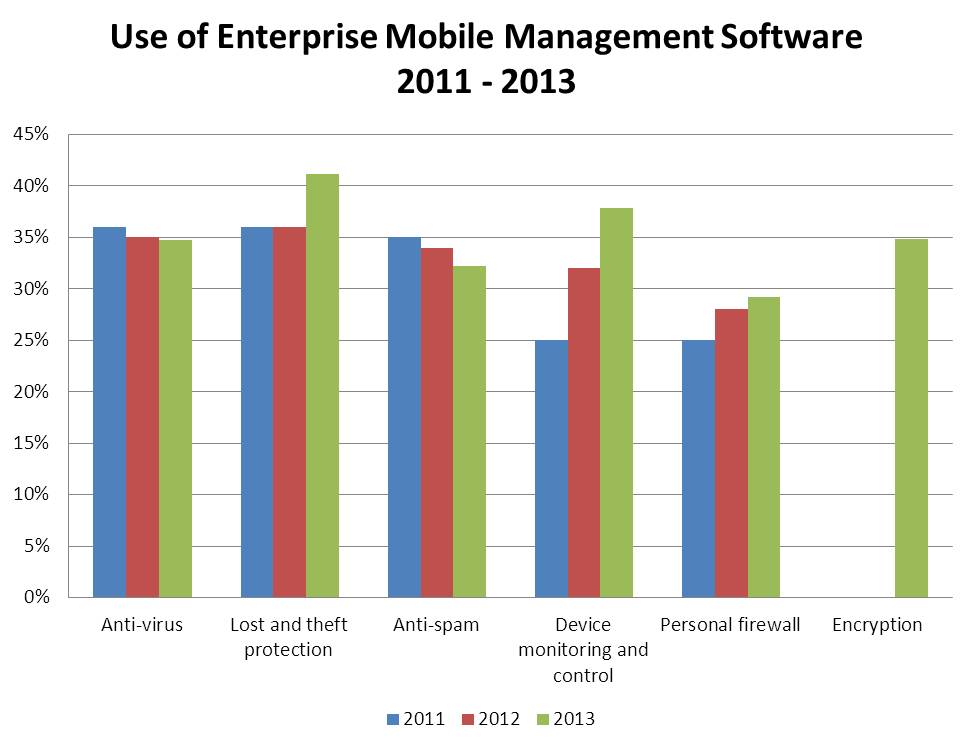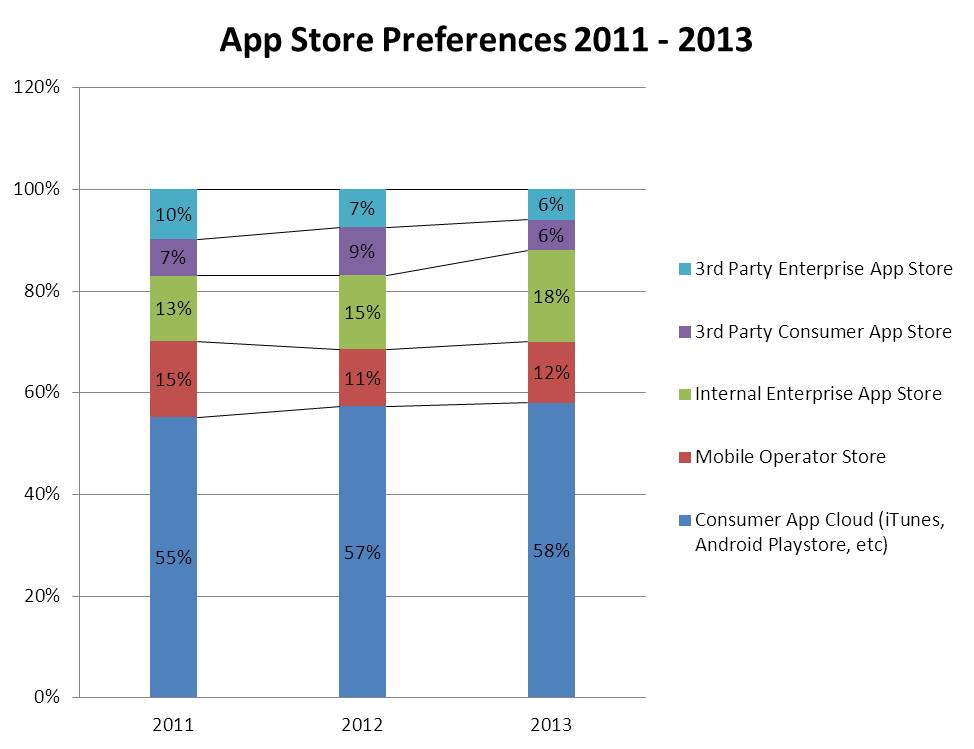We have surveyed and studied trends in the mobile market for five years and, until last year, noted little change in the debates on best practices and preferences in several issues. But our recently published 2013 Wisdom of Crowds® Mobile Computing / Mobile Business Intelligence Market Study clearly shows that opinions changed in the past year.
We collected survey data in September-October 2013 from 1,182 top-management and BI executives for our fifth annual benchmark study. Their companies range in size from fewer than 100 employees to more than 5,000, cover more than 14 industries and a wide array of geographies (22 EMEA countries, eight APAC countries, four Canadian provinces and 30 U.S. states).
Here are some of the highlights.
Mobile priorities
Email still ranks as the #1 priority for mobile access and business intelligence applications still rank #3. Video conferencing/chat has grown in importance, although it’s still nascent. Mobile payments rank #8 of 11 user priorities.
Mobile security
Our 2013 survey participants reported a higher focus on mobile device management (MDM) software, especially for loss and theft protection and personal firewall, than in the prior two years. As shown in the chart below, encryption is also a high priority (2013 is the first year we included encryption in the survey).

There are several reasons for this increased focus on mobile security software solutions. Certainly there are more users, but I think the main reason is that organizations and the IT function have come to the realization that mobile will be a dominant form of computing within their base and they need to take it much more seriously.
Like the Internet, mobile computing is not going away. Organizations need to embrace it and make it part of their strategy; and that includes making sure they have the technology and policies in place to deal with encrypting information, lost devices, etc. so they can minimize the impact in the event an employee loses a device or someone intercepts information.
Where should mobile apps reside?
This issue has been at the center of security and governance best-practices debate for years, with westernized organizations wanting applications on their servers and users wanting downloadable apps with data on their devices.
This year our study reveals a gradual but overarching trend in favor of hosted applications where, at a minimum, the data doesn’t move down to the device.
Two primary factors account for this shift. Obviously organizations experienced some major information security breaches over the past years. The other factor is increasingly pervasive network access (even on airplanes). With ready connectivity no matter where we are, the need for data download to a local device is less pressing.
Mobile platforms
In our five years of benchmarking this aspect of mobile computing, Apple’s iOS devices remained the top priority in mobile platforms through 2012, followed closely by Android. Our 2013 study shows a changing vendor landscape. Windows 8 phones and tablets increased in importance, with modest but definite growth today and significant deployment plans over the next two years.
Over the years Apple achieved pretty good saturation, especially for the iPad, which has done very well in the enterprise. Those devices won’t go away. The question is which new devices will organizations and users purchase?
Organizations have significant plans for Windows 8 across the enterprise and across mobile devices and tablets that they did not fully realize last year. What happens this year depends on whether Microsoft will get its house in order and not back away from its strategy. The Surface appears to be a very good device, and it integrates with the rest of the Windows family; so Microsoft may eventually gain ground in this race. But Microsoft tends to have a short attention span, abandoning products after a short while if they don’t achieve early success. We don’t know what will happen in the post-Ballmer world, but Microsoft has a real opportunity if it is persistent and aggressive in the marketplace.
Native vs. HTML5
Opinions in this ongoing debate are still transitioning. Certainly a lot of organizations would like HTML5 to be the answer, but that’s not what the users want. Our study reveals that users prefer downloadable apps because they tend to be faster, more visual and can operate in an offline environment. But users indicate they would have no preference if HTML5 catches up and meets their needs for fast, visual, intuitive apps.
The use of hybrid applications that adhere to the app store approach is increasing. It’s basically a shell developed around HTML5. I think, longer term, hybrid might be the best approach. Developers can develop an application once using HTML5 and then create wrappers according to placement in a particular app store.
Although the majority of respondents indicated they have no plans for in-house development of mobile apps, I was surprised at how many participants reported they “have” or “are” developing mobile aps in house. Most of these apps are likely company process specific and very task oriented.
Enterprise app stores
The axiom “There’s an app for that” is usually true. Apple and Google have done an especially good job of training people and the vendors on this mindset. But many of our survey participants reported their organizations intend to shift mobile application purchasing away from consumer app stores (e.g., Apple iTunes, Google Play Store, Windows Store) to internal enterprise app stores.
However, our study found that, although interest in enterprise app stores grew in 2013, consumer app stores also continued to thrive. As the chart below shows, third-party enterprise and consumer app stores (e.g., AT&T, Verizon and other mobile service providers) are losing ground.

With five years of benchmarks, we can see real trends in purchase preferences. I think that the practice of buying apps through consumer app stores won’t give way soon. But this practice may level off as organizations (especially large ones) clearly want to take control as buying from consumer app stores creates governance issues. But quite frankly, with the consumerization of IT, they’re not in the driver’s seat. Consumers and the vendors that support the infrastructure ultimately will be the determinants.
Location awareness and device integration priorities
To our survey question about requirements for business intelligence integration with local device capabilities, this year we also asked participants to rank context awareness as well as smart watch and Google Glass integration.
Out of the nine capabilities we queried, the majority of respondents ranked “multi-touch interface” as their top requirement and “location awareness” as #2, indicating both are “critical” or “very important.”
I’m a big fan of wearable technology. From a BI perspective, I think integration with smart watches for alerts is useful. With people wearing more and sensors, users want more relevant information based on context awareness related to a particular activity or location awareness.
With location awareness, for example, a retail executive can walk into a store and click a button for “Where am I?” and relevant statistics for that particular store. Or the information could even be based on a particular location with a store.
Google Glass or whatever comes after it could be very interesting in business intelligence. I tried an oculus display (worn like goggles) in which the user can build models and then walk around in them and interact with them. Some really cool technology will come to the fore, allowing users to have a much more visceral experience with data, information and applications. And these technologies will become even more sophisticated.
Advice for mobile BI customers
Organizations looking to deploy mobile BI solutions need to recognize that their existing infrastructure will certainly become inadequate over the course this this year. The folks that I’ve spoken with that have deployed mobile BI had to really bolster their data infrastructure because the existing data warehouse or whatever solution they used couldn’t handle the mobile load. People use mobile devices more frequently to query BI data. Multiply that times hundreds or thousands of users, and it will exhaust the resources most organizations have. Folks have told me their organizations switched to in-memory databases, columnar databases and various appliances — infrastructure that can handle the increased demand for the data.
As I mentioned before, mobile computing and BI are not going away; in fact, use will intensify. Organizations must embrace this new reality and deal with what it brings from a skills and infrastructure perspective.
My observation is that mobile BI is no longer a market. There are a couple of mobile vendor stragglers; but for the most part, mobile BI is now just a feature every BI vendor offers. Today the marketplace has many good options, so trying to bring in a new vendor solution that is just for mobile probably doesn’t make sense for organizations that have a BI vendor they already like. Call up the vendor and ask for a mobile demo.
Mobile BI vendor rankings
A notable finding in our 2013 mobile survey is that the participants ranked vendors as much tighter competitors than in the prior two years.
Some vendors were early visionaries in the market and, as innovators, were great at blazing trails. But others have caught up and there is much more parity now. For instance, all the dashboards look largely alike. Innovation in mobile business intelligence is now more difficult.
Where is a paradigm shift when we need one? Obviously we don’t know exactly what will come next, but there is someone in a garage somewhere developing something under the radar now that will turn this market on its ear. And I can’t wait to see it. It will be a great disrupter for today’s dominant vendors.
The report on the 2013 Wisdom of Crowds® Mobile Computing / Mobile Business Intelligence Market Study is available at http://www.mobilecomputingreport.com. In addition to more details on the aspects discussed in this article, the report includes information on mobile BI user targets by industry, mobile BI adoption plans through 2016, expected exclusive mobile BI usage by 2015 (by geography, function, organization size), feature priorities, benefits and limitations, industry support for BI features, and more.
The Wisdom of Crowds ® Mobile Computing / Mobile Business Intelligence Market Study was conceived and executed by Dresner Advisory Services, LLC, an independent advisory firm, and Howard Dresner, its president, founder and chief research officer. Howard Dresner is one of the foremost thought leaders in Business Intelligence and Performance Management, having coined the term “Business Intelligence” in 1989. He has published two books on the subject, “The Performance Management Revolution — Business Results through Insight and Action,” and “Profiles in Performance — Business Intelligence Journeys and the Roadmap for Change.” Prior to Dresner Advisory Services, Howard served as chief strategy officer at Hyperion Solutions and was a research fellow at Gartner, where he led its Business Intelligence research practice for 13 years.
